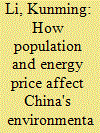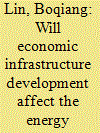| Srl | Item |
| 1 |
ID:
166528


|
|
|
|
|
| Summary/Abstract |
This paper examines the impact of population and energy price on China's environmental pollution through both industrial and residential channels. Our theoretical models reveal that the influences of population on environmental pollution are contingent on wage stickiness and wage elasticity. We also predict that environment pollution decreases with rising energy price, but downward energy price distortion intensifies environmental pollution. We test these hypotheses using panel data of 30 Chinese provinces from 2001 to 2016 and employing both constant coefficient and time-varying coefficient panel data models to conduct analyses. Our empirical results show that population growth, increased urbanization, and energy price distortion all intensify environmental pollution, while population aging and rising energy price tend to alleviate environmental pollution. Our results also reveal significant regional and time heterogeneity on the impact of population factors and energy price on China's environmental pollution.
|
|
|
|
|
|
|
|
|
|
|
|
|
|
|
|
| 2 |
ID:
166940


|
|
|
|
|
| Summary/Abstract |
China's manufacturing industry consumes more energy than the total amounts of Germany, Britain, France, Spain and Japan combined, and has a substantial impact on energy conservation and emissions reduction. This paper investigates the influence mechanism of economic infrastructure on the energy consumption and energy intensity of the sector. Using the China's provincial data during the period 2003–2016, the profit function is applied to incorporate infrastructure into the input-output system, and to avoid the endogenous problems caused by the reverse causal relationship between energy consumption and infrastructure construction. The empirical results indicate that economic infrastructure construction will increase energy consumption and reduce the energy intensity in the long term. Although the energy consumption effect of infrastructure in the central and western regions is less than that in the eastern region, the energy intensity of the western region declines the most due to the infrastructure construction. Based on the results of this paper, some policy implications are discussed. This paper also offers some targeted policy recommendations to improve policy design of the government.
|
|
|
|
|
|
|
|
|
|
|
|
|
|
|
|